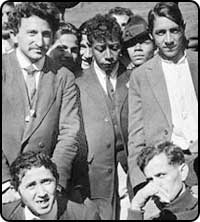 |





|
 |
Russian American Immigration

Russian men entering through Angel Island.
|
Immigrants from Russia entered the United States at both coasts starting in the late 1800s. Nearly 3 million Russians entered during the first wave of open immigration that began in the late 19th century and continued into the early 20th century. However, only about 20,000 found their way into America during the period that followed the Bolshevik Revolution of 1917 up through World War II.
World War I, the Russian Revolution, and then the Bolshevik Revolution produced refugees who lost their homes and livelihoods. Nearly 1 million fled the country. Many Russians who ended up in Siberia and Manchuria, whether migrating for work or fleeing violent conflicts, found their way to the American West Coast -- first stop, the Angel Island Immigration Station, where the average stay of a Russian ranged from a few days to four months.
But after World War I ended, the United States, which didn't ratify the League of Nations charter, became extremely isolationist. Americans were fearful of the troubles of the outside world and likewise of foreigners, so the U.S. immigration laws became more restrictive.

Russian women and children waiting to be processed.
|
The 1921 and 1924 U.S. immigration laws reduced the number of people allowed to come from southern and eastern Europe, which dropped the number of Russian immigrants to about 2,248 per year. Although they were not subjected to the extreme interrogations at Angel Island to which the Chinese were subjected, they could be excluded on the basis of extreme poverty which would make them "likely to become a public charge"; disease and chronic ill health, which would render them unable to work; and the subjective judgment that they might turn to prostitution to earn a living.
Moreover, the 1917 immigration law required that immigrants be able to prove they were literate in their own language. If they were not able to read a paragraph in their own language, they would be marked for deportation.
And finally, American reaction to the waves of domestic labor strikes and the Bolshevik Revolution resulted in the "Red Scare" of the 1920s. Thousands of Russian immigrants and labor activists were swept up in the Palmer Raids, named for then-U.S. Attorney General Mitchell Palmer, and held without trial. More than 500 individuals were deported on suspicion of so-called radical political activity.
|






